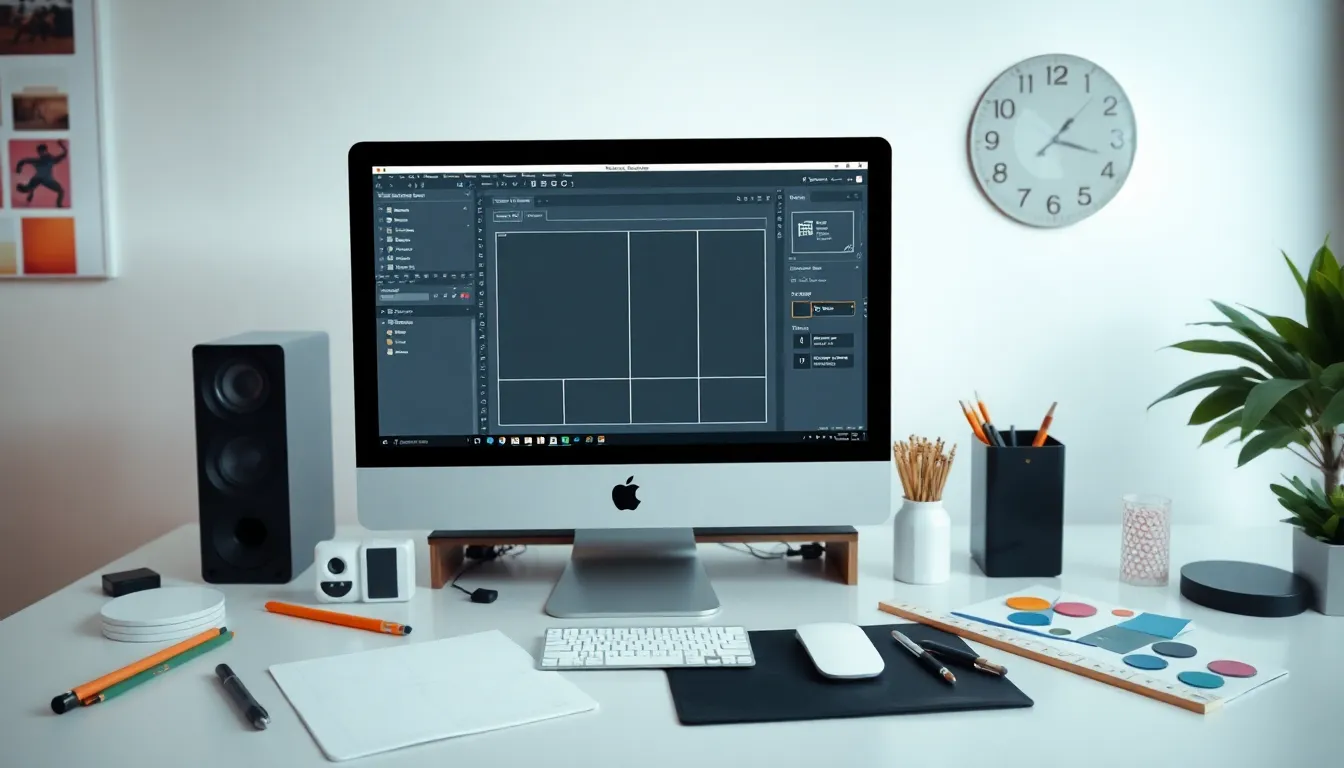In the ever-evolving world of web design, CSS grids have emerged as the unsung heroes of layout magic. They’re like the Swiss Army knife of styling—versatile, powerful, and just a little bit intimidating at first glance. But fear not! Once you unlock the secrets of CSS grids, you’ll wonder how you ever lived without them.
Table of Contents
ToggleOverview of CSS Grids
CSS grids establish a robust framework for web layouts, enabling designers to create complex and responsive designs with ease. A grid comprises rows and columns, allowing content to be organized systematically. Key benefits include flexibility in design and precise control over element placement.
Creating a basic grid starts with the display: grid property. This declaration transforms any container into a grid layout. Additional properties, like grid-template-columns and grid-template-rows, define the number of columns and rows required.
Units play a crucial role in grid design. Designers use fixed units, like pixels, or flexible units, like fractions (fr), to allocate space within a grid. Using fractional units offers responsive design benefits, automatically adjusting sizes based on available space.
Grid gaps provide spacing between grid items. The grid-gap property sets the desired amount of space, streamlining the visual appearance. This adjustment improves readability and accessibility across devices.
CSS grids support various layout techniques, like overlapping grid items and spanning across multiple columns or rows. Utilizing properties such as grid-column and grid-row enables such positioning, enhancing design creativity. Additionally, media queries facilitate responsive layouts, ensuring designs adapt to different screen sizes.
Browser support for CSS grids is extensive, with all modern browsers offering compatibility. This widespread support empowers designers to implement grids confidently, knowing they will function as intended across platforms. Overall, CSS grids revolutionize web design efficiency and effectiveness.
Key Features of CSS Grids

CSS grids offer a range of features designed to enhance layout creation. Understanding these features can significantly improve design effectiveness.
Flexible Layouts
Flexible layouts in CSS grids allow designers to create adaptive structures. Rows and columns can adjust to various screen sizes, ensuring content displays optimally. Fractional units like fr allocate space efficiently, promoting responsiveness. Designers can easily rearrange items without affecting overall layout integrity. Using properties such as grid-template-areas, one defines specific areas for content, allowing for creative freedom. Components can span multiple rows or columns, increasing design flexibility. Media queries enable further adjustments based on different device sizes, enhancing user experience.
Grid Templates
Grid templates simplify layout management through predefined structures. Designers establish a grid configuration using properties like grid-template-columns and grid-template-rows. These properties determine the size and number of columns and rows within a grid. Named grid areas offer additional clarity, making it straightforward to visualize placements. The ability to create complex layouts becomes hassle-free with these templates, as designers can focus on visual arrangement rather than calculations. Combining grid templates with the grid-auto-flow property optimizes item placement, benefiting content-heavy designs well.
Benefits of Using CSS Grids
CSS grids offer several advantages that enhance web design efficiency. These benefits contribute to creating a seamless user experience across devices.
Responsive Design
CSS grids excel in responsive design. Flexibility in layout adapts to various screen sizes without sacrificing content clarity. Designers can utilize fractional units to allocate space dynamically. This method simplifies the rearrangement of items, making adjustments quick and stress-free. Rules like media queries seamlessly integrate with the grid layout, ensuring responsiveness. Any screen size, from mobile to desktop, benefits from a consistent look and feel. Designers achieve layouts that look polished and professional under all conditions with CSS grids.
Simplified Alignment
Simplified alignment plays a crucial role in CSS grids. With grid properties like grid-template-columns, precise positioning of items becomes effortless. Designers no longer struggle with manual adjustments when aligning elements. Each item snaps into place along defined lines, enhancing overall organization. Defining areas with grid-template-areas allows for intuitive layouts that improve readability. Use of the grid-auto-flow property further optimizes item placement, especially in complex designs. As a result, alignment becomes a straightforward process that enhances the overall aesthetic quality.
Common Use Cases for CSS Grids
CSS grids serve various practical purposes in web design, enhancing layout efficiency and aesthetic appeal. They allow for significant flexibility, accommodating diverse design needs.
Web Design
CSS grids excel in web design, streamlining the layout process. Designers rely on grids to create structured and intuitive user interfaces. Utilizing grid properties promotes consistent organization, resulting in visually appealing sites. Specific layouts like multi-column setups or asymmetrical designs become simpler with grids. Responsive behavior improves as items shift seamlessly across screen sizes, maintaining readability. Complex content can nest without clutter, thanks to advanced placement techniques. Browsers support grids widely, ensuring compatibility across devices.
Application Layouts
Application layouts benefit greatly from CSS grids, facilitating intricate design layouts with ease. Grids help organize various components like navigation bars, side menus, and content sections effectively. Customizable grid templates allow for rapid development, appealing for both web and mobile apps. Features like grid areas enhance the layout structure, clearly defining sections. Designers can manipulate layouts quickly, adjusting spacing or repositioning elements as needed. Cohesive designs emerge as elements align consistently, improving user interaction. Overall, CSS grids foster a more efficient workflow in application design, saving time while boosting functional aesthetics.
CSS grids have transformed the landscape of web design by offering a structured yet flexible approach to layout creation. Their ability to adapt to various screen sizes while maintaining clarity and organization is unmatched. Designers can harness the power of CSS grids to create visually stunning and user-friendly interfaces with minimal effort.
By utilizing features like fractional units and grid templates, they can streamline their workflow and enhance overall efficiency. As web design continues to evolve, embracing CSS grids will undoubtedly lead to more innovative and responsive designs, making them an indispensable tool for any modern designer.



